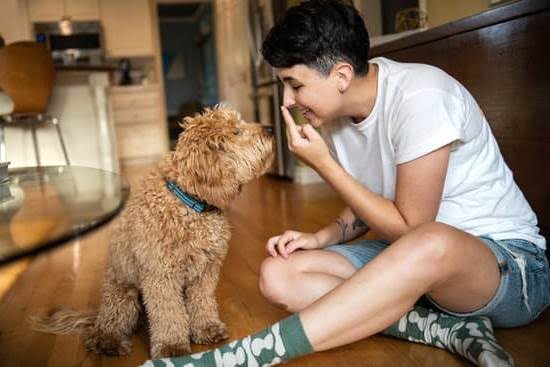Clicker training is a popular and effective method to teach your dog new behaviors and reinforce positive ones. Knowing when to start clicker training your dog is crucial in ensuring successful results. This article will guide you through the basics of clicker training, including the benefits it offers to your furry friend. Whether you have a young puppy or an older dog, understanding the fundamentals of clicker training can make a significant difference in their behavior and obedience.
Clicker training relies on the use of a small handheld device that emits a distinct clicking sound, serving as a signal for your dog to associate with positive reinforcement. This form of operant conditioning has been proven to be highly successful in shaping desired behaviors in dogs of all ages and breeds. By timing the click precisely with the desired behavior, you can communicate effectively with your dog and strengthen their understanding of commands.
By starting clicker training at the right age, you can establish a strong foundation for further learning and development in your dog. It is essential to consider factors such as your dog’s attention span, motivation, and overall readiness for training before diving into clicker exercises.
In the following sections, we will explore the ideal age to begin clicker training, how to recognize signs that your dog is ready, and the necessary supplies you will need to get started on this rewarding journey towards improved behavior and communication with your canine companion.
Benefits of Clicker Training for Dogs
Clicker training has gained popularity amongst dog owners as an effective and positive reinforcement training method that can help improve your dog’s behavior. One of the key benefits of clicker training for dogs is its ability to establish clear communication between you and your pet. By using a clicker as a marker for desired behaviors, you are able to clearly communicate to your dog what actions will earn them a reward.
Enhanced Bonding
Another major benefit of clicker training is the enhanced bonding experience it provides between you and your furry friend. Through consistent and positive interactions during training sessions, you are able to strengthen your relationship with your dog. The mutual understanding built through clicker training helps foster trust and respect, leading to a more harmonious relationship between you and your canine companion.
Increased Engagement
Clicker training also helps increase engagement and focus in your dog. The repetitive sound of the clicker serves as a signal for your dog to pay attention and perform the desired behavior in order to receive a reward. This heightened level of engagement can make training sessions more effective and enjoyable for both you and your pet. Additionally, clicker training can help build confidence in shy or anxious dogs, as they learn to associate the click with success and praise.
What Age Is Ideal to Begin Clicker Training
When to start clicker training your dog is a common question among pet owners. The ideal age to begin clicker training your dog is around 8-12 weeks old. At this age, puppies are in their critical socialization period and are more receptive to learning new behaviors. However, it is never too late to start clicker training with an older dog. Dogs of any age can benefit from the positive reinforcement and mental stimulation that clicker training provides.
Starting clicker training at a young age has several benefits. It helps build a strong bond between you and your dog, improves communication, and promotes good behavior early on. Puppies have a shorter attention span compared to adult dogs, so starting early allows them to develop focus and concentration through short training sessions. Clicker training also sets a foundation for lifelong learning and can be used to teach various tricks and commands as your dog grows older.
It’s important to remember that every dog is different, so the readiness for clicker training may vary. Some signs that your dog is ready for clicker training include showing interest in treats, being eager to learn new things, and displaying good behavior during basic obedience training sessions.
Regardless of the age at which you start clicker training your dog, patience, consistency, and positive reinforcement are key elements for success. Training should always be a fun and rewarding experience for both you and your furry companion.
| Age | Ideal Characteristics |
|---|---|
| 8-12 weeks old | Receptive to learning new behaviors, short attention span |
| Older dogs | Can benefit from positive reinforcement and mental stimulation |
Signs Your Dog Is Ready for Clicker Training
Dogs communicate with us in many ways, but how do you know when your furry friend is ready to start clicker training? One key sign is their level of focus and attention. If your dog is easily distracted or struggles to pay attention for an extended period, it may be best to wait until they can maintain focus for a reasonable amount of time.
Additionally, observe your dog’s behavior during training sessions – are they engaged and eager to learn, or do they seem disinterested and unresponsive? Recognizing these signs can help you determine if now is the right time to start clicker training.
Another important factor to consider is your dog’s willingness to work for rewards. Clicker training relies on positive reinforcement through treats or praise, so it’s essential that your dog finds motivation in these rewards.
If your pup responds well to treats or gets excited at the prospect of earning a reward, they are likely ready for clicker training. However, if your dog shows little interest in rewards or does not seem motivated by treats during training sessions, it may be helpful to work on building their drive before introducing the clicker.
Lastly, consider your dog’s overall comfort level with learning new behaviors and commands. Some dogs may be more receptive to training than others, so it’s crucial to assess your dog’s personality and temperament before starting clicker training.
If your dog enjoys learning new tricks or follows commands easily, they may be well-suited for clicker training. However, if your dog becomes easily frustrated or stressed during training exercises, it may be beneficial to work on building their confidence and trust before incorporating the clicker into their training routine.
| Key Sign | How It Helps |
|---|---|
| Focused Attention | Determines readiness based on ability to concentrate |
| Response to Rewards | Evaluates motivation levels for positive reinforcement |
| Comfort with Learning | Assesses receptiveness and suitability for new behaviors |
Supplies Needed for Clicker Training
When starting clicker training with your dog, it is important to have the right supplies on hand to ensure a successful training session. The basic supplies needed for clicker training include a clicker, treats, and a willing attitude from both you and your furry friend.
The Clicker
The clicker is a small handheld device that emits a distinct sound when pressed. This sound is used to mark the precise moment when your dog performs the desired behavior. It serves as a clear communication tool for your dog, indicating that they have done something right and will receive a reward.
Treats
Treats are an essential part of clicker training as they serve as the motivator for your dog to continue performing the desired behavior. When selecting treats for clicker training, opt for small, soft treats that can be easily consumed by your dog in quick succession without disrupting the flow of the training session.
A Willing Attitude
Apart from physical supplies like the clicker and treats, having a willing attitude towards clicker training is crucial for its success. Patience, consistency, and positive reinforcement are key components of effective clicker training. Remember that each dog learns at their own pace, so approach each training session with a positive mindset and be prepared to adapt to your dog’s individual needs and learning style.
How to Introduce the Clicker to Your Dog
Introducing the clicker to your dog is an essential step in starting clicker training. The clicker serves as a marker for the exact moment your dog does the desired behavior, signaling to them that a reward is on the way. Here are some steps to help you effectively introduce the clicker to your furry friend:
1. Choose the right environment: Find a quiet and familiar space where your dog feels comfortable. Minimize distractions to help them focus on the sound of the clicker.
2. Familiarize your dog with the clicker: Before using it for training, let your dog get used to the sound of the clicker. Click and immediately give them a treat several times without expecting any specific behavior from them.
3. Associate the click with rewards: Pair the sound of the clicker with tasty treats or their favorite toy. Click and immediately follow up with a reward, repeating this process multiple times so they understand that good things come after hearing the click.
4. Practice timing: Practice clicking at the exact moment your dog offers a desirable behavior, such as sitting or laying down. Timing is crucial in clicker training, so make sure to be consistent and precise when clicking.
By following these steps, you can successfully introduce the clicker to your dog and start implementing positive reinforcement techniques in their training routine. Remember, patience and consistency are key when starting this training method with your furry companion.
Step-by-Step Guide to Clicker Training
Clicker training is a positive reinforcement method that can be highly effective in teaching dogs new behaviors or commands. If you are wondering when to start clicker training your dog, the answer is: as soon as possible. Dogs of all ages can benefit from clicker training, but starting at a young age can help establish good habits early on.
To begin clicker training your dog, follow these steps:
- Get your supplies ready: Before you start clicker training, make sure you have a clicker and some tasty treats handy.
- Charge the clicker: Begin by associating the sound of the clicker with something positive. Click the clicker and immediately give your dog a treat.
- Start with simple commands: Choose a basic command such as “sit” or “down” to begin with. When your dog performs the desired behavior, click and reward them with a treat.
As you progress with clicker training, you can move on to more complex behaviors and commands. Remember to keep training sessions short and fun for your dog to maintain their interest and motivation. With consistency and patience, you will see improvement in your dog’s behavior over time.
By following this step-by-step guide to clicker training, you can strengthen the bond between you and your furry friend while also reinforcing positive behavior. Keep practicing regularly, stay patient, and celebrate small victories along the way. Happy training.
Common Mistakes to Avoid in Clicker Training
Clicker training can be a highly effective method for teaching your dog new behaviors, but it’s important to approach it with care to ensure success. Avoiding common mistakes can help make the training process smoother and more rewarding for both you and your furry friend.
One of the biggest mistakes dog owners make is starting clicker training without fully understanding the basics. Before diving into clicker training, take the time to learn how the clicker works and its role in positive reinforcement.
Another common mistake to avoid is using the clicker as a punishment or a signal of disapproval. The clicker should always be associated with positive reinforcement and rewards, signaling to your dog that they’ve done something right. Using the clicker in a negative way can confuse your dog and hinder their progress in learning new behaviors.
It’s important to remember that consistency is key in clicker training. Inconsistencies in timing or reinforcement can lead to confusion for your dog, making it harder for them to understand what behavior is being rewarded.
Lastly, one of the most important mistakes to avoid is giving up too soon on clicker training. Training takes time, patience, and practice – both for you and your dog. If you’re not seeing immediate results, don’t get discouraged. Keep practicing, stay consistent with your methods, and be patient with your furry companion. With dedication and perseverance, you’ll likely see great improvements in your dog’s behavior through clicker training over time.
Advanced Tips for Clicker Training Success
As a pet owner, understanding the basics of clicker training is essential before delving into advanced tips for success. Clicker training involves using a small device that makes a clicking sound to indicate to your dog when they have performed the desired behavior. This positive reinforcement technique can be highly effective in shaping your dog’s behavior and fostering a stronger bond between you and your furry companion.
One of the key benefits of clicker training for dogs is its ability to communicate with them clearly and consistently. By using a clicker as a signal for good behavior, you can reinforce positive actions instantaneously, making it easier for your dog to understand what you expect from them. This method also helps reduce confusion and frustration for both you and your pet, leading to more successful training sessions.
Determining the ideal age to start clicker training your dog is crucial for their learning and development. While there is no specific age requirement, experts recommend starting as early as possible to establish good habits and behaviors.
Puppies as young as eight weeks old can begin clicker training, as long as they are able to focus and follow basic commands. However, it’s never too late to start clicker training with an older dog – it’s just a matter of adjusting the pace of the training sessions based on their age and abilities.
Conclusion
Clicker training can have a significant impact on your dog’s behavior and overall well-being. By utilizing positive reinforcement techniques, you are not only teaching your dog desired behaviors but also strengthening the bond between you and your furry friend.
The consistent use of a clicker to mark good behavior, followed by a reward, helps your dog understand what is expected of them and encourages them to repeat those behaviors in the future. This method of training promotes communication, trust, and mutual respect between you and your canine companion.
Knowing when to start clicker training your dog is crucial in ensuring its effectiveness. The ideal age to begin clicker training is as early as possible, preferably when your dog is still a puppy. Puppies have an eagerness to learn and are highly impressionable during this developmental stage. However, it’s never too late to start clicker training with an older dog; with patience and consistency, dogs of any age can benefit from this form of positive reinforcement training.
In conclusion, clicker training offers numerous benefits for both you and your dog. It not only improves obedience and behavior but also provides mental stimulation and strengthens the bond between you and your four-legged companion.
By understanding the basics of clicker training, recognizing the signs that indicate readiness, and following a step-by-step guide, you can set your dog up for success in their training journey. Remember to be patient, consistent, and always use positive reinforcement to ensure a harmonious relationship with your well-trained pup.
Frequently Asked Questions
What Age Should You Start Clicker Training?
The age at which you can start clicker training your dog varies, but it is generally recommended to begin around 8-12 weeks old. This is a good time to introduce basic commands and positive reinforcement techniques.
How Do I Introduce My Dog to Clicker Training?
To introduce your dog to clicker training, start by associating the clicking sound with a treat. Click the clicker and immediately give your dog a treat several times in a row. This will help them understand that the click means they did something right.
Can You Clicker Train a 8 Week Old Puppy?
Yes, you can start clicker training an 8-week-old puppy. Keep training sessions short and fun to keep their attention span in mind. Use high-value treats to reward good behavior and be patient with their learning process.

Welcome to the blog! I am a professional dog trainer and have been working with dogs for many years. In this blog, I will be discussing various topics related to dog training, including tips, tricks, and advice. I hope you find this information helpful and informative. Thanks for reading!





